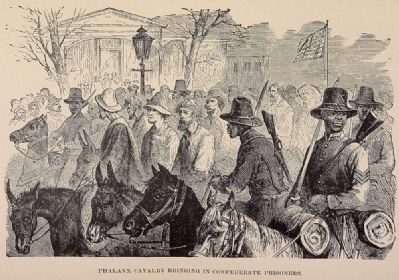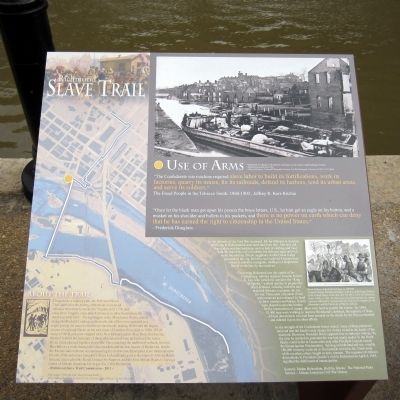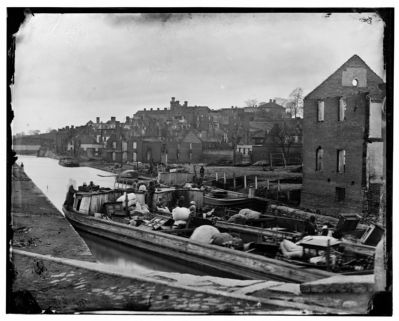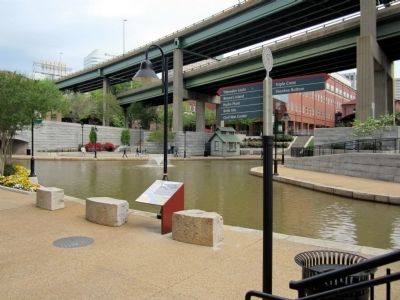Shockoe Slip in Richmond, Virginia — The American South (Mid-Atlantic)
Use of Arms
— Richmond Slave Trail —
“The Confederate war machine required slave labor to build its fortifications, work its factories, quarry its mines, fix its railroads, defend its harbors, tend its urban areas, and serve its soldiers.”
The Freed People in the Tobacco South: 1860-1900, Jeffrey R. Kerr-Ritchie
“Once let the black man get upon his person the brass letters, U.S., let him get an eagle on his button, and a musket on his shoulder and bullets in his pockets, and there is no power on earth which can deny that he has earned the right to citizenship in the United States.”
- Frederick Douglass
As the intensity of the Civil War increased, life for Africans in America and living in Richmond became more and more dire. Not only did they endure wartime hardships such as lack of clothing and food with the rest of the city’s residents, but Africans especially fell under the scrutiny of their neighbors. As the Union troops approached the city, both free and enslaved Africans were viewed as potential insurgents, leading to a heightened fear of a rebellion by the enslaved.
Converting Richmond into the capital of the Confederacy, military engineer General Robert E. Lee, who earned the moniker, the “King of Spades,” worked quickly to prepare the city’s defenses, enlisting both free and enslaved Africans to prepare the city for war. Thousands of pounds of soil were removed and reshaped by hand to form trenches and berms; forests were cleared to provide lumber for the construction of camps; dikes were built to control the waters. By 1864, 10,000 men were working to improve Richmond’s defenses, the majority of them African descendents who had been arrested on the streets by the Provost Marshal and ordered to join the labor efforts.
As the strength of the Confederate forces waned, many military personnel believed that the South’s only chance for victory rested in the hands of the enslaved. However, President Davis opposed this recruitment strategy; by the time he realized its potential the war had nearly ended. In the North, blacks could enlist in Union units only after President Lincoln issued the Emancipation Proclamation. Serving on both land and sea, roughly 180,000 formerly enslaved or freed people served in the Union army while countless others fought as navy seamen. The response of Africa’s descendants to President Lincoln’s visit to Richmond on April 4, 1865 signified the fulfillment of emancipation.
Sources: Selden Richardson, Built by Blacks; The National Parks Service — African American Civil War History
Erected 2011 by Richmond Slave Trail Commission. (Marker Number 10.)
Topics and series. This historical marker
is listed in these topic lists: Abolition & Underground RR • African Americans • War, US Civil. In addition, it is included in the Former U.S. Presidents: #16 Abraham Lincoln series list. A significant historical month for this entry is April 1793.
Location. This marker has been replaced by another marker nearby. It was located near 37° 31.979′ N, 77° 25.987′ W. Marker was in Richmond, Virginia. It was in Shockoe Slip. Marker could be reached from the intersection of S 14th Street (U.S. 360) and Dock Street. This marker is on the Richmond Riverfront Canal Walk between S 14th Street and Virginia Street. Touch for map. Marker was in this post office area: Richmond VA 23219, United States of America. Touch for directions.
Other nearby markers. At least 8 other markers are within walking distance of this location. A different marker also named Use of Arms (here, next to this marker); New Turning Basin (within shouting distance of this marker); Mayo's Bridge (within shouting distance of this marker); Atlantic Sturgeon (within shouting distance of this marker); James River & Kanawha Canal (within shouting distance of this marker); James River Bateaumen

3. Black Soldiers in the Federal Army, ca. 1863-64
Joseph T. Wilson, The Black Phalanx: A History of the Negro Soldiers of the United Sates in the War of 1775-1812, 1861-’65 (Hartford, Conn., 188), p. 236. As shown on www.slaveryimages.org (image reference Wilson237), sponsored by the Virginia Foundation for the Humanities and the University of Virginia Library.
Related marker. Click here for another marker that is related to this marker. This marker has been replaced with the linked marker, which has an updated inscription.
Credits. This page was last revised on November 10, 2023. It was originally submitted on April 22, 2011, by Bernard Fisher of Richmond, Virginia. This page has been viewed 659 times since then and 10 times this year. Photos: 1, 2, 3, 4. submitted on April 22, 2011, by Bernard Fisher of Richmond, Virginia.


